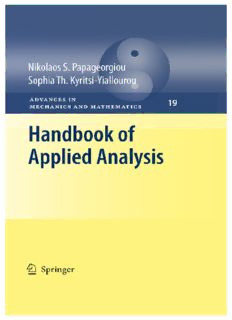Table Of ContentHANDBOOK OF APPLIED ANALYSIS
For other titles published in this series, go to
www.springer.com/series/5613
Advances in Mechanics and Mathematics
VOLUME 19
Series Editors
David Y. Gao (Virginia Polytechnic Institute and State University)
Ray W. Ogden (University of Glasgow)
Advisory Board
Ivar Ekeland (University of British Columbia, Vancouver)
Tim Healey (Cornell University, USA)
Kumbakonam Rajagopal (Texas A&M University, USA)
Tudor Ratiu (École Polytechnique Fédérale, Lausanne)
David J. Steigmann (University of California, Berkeley)
Aims and Scope
Mechanics and mathematics have been complementary partners since Newton’s
time, and the history of science shows much evidence of the beneficial influence of
these disciplines on each other. The discipline of mechanics, for this series,
includes relevant physical and biological phenomena such as: electromagnetic,
thermal, quantum effects, biomechanics, nanomechanics, multiscale modeling,
dynamical systems, optimization and control, and computational methods.
Driven by increasingly elaborate modern technological applications, the symbiotic
relationship between mathematics and mechanics is continually growing. The
increasingly large number of specialist journals has generated a complementarity
gap between the partners, and this gap continues to widen. Advances in Mechanics
and Mathematics is a series dedicated to the publication of the latest developments
in the interaction between mechanics and mathematics and intends to bridge the
gap by providing interdisciplinary publications in the form of monographs,
graduate texts, edited volumes, and a special annual book consisting of invited
survey articles.
HANDBOOK OF APPLIED ANALYSIS
By
NIKOLAOS S. PAPAGEORGIOU
National Technical University, Athens, Greece
SOPHIA TH. KYRITSI-YIALLOUROU
Hellenic Naval Academy, Piraeu s ,Greece
123
N.S. Papageorgiou S. Th. Kyritsi-Yiallourou
National Technical University Hellenic Naval Academy
Department of Mathematics Military Institute of University Education
157 80 Athens Leoforos Chatzikyriakou
Zografou Campus 185 39 Piraeus
Greece Greece
[email protected] sky [email protected]
Series Editors:
David Y. Gao Ray W. Ogden
Department of Mathematics Department of Mathematics
Virginia Polytechnic Institute University of Glasgow
and State University Glasgow, Scotland, UK
Blacksburg, VA 24061 [email protected]
[email protected]
ISBN 978-0-387-78906-4 e-ISBN 978-0-387-78907-1
DOI 10.1007/b120946
Springer Dordrecht Heidelberg London New York
Library of Congress Control Number: 2009927202
Mathematics Subject Classification (2000): 34xx, 35xx, 46xx, 47xx, 49xx, 90xx, 91xx
© Springer Science+Business Media, LLC 2009
All rights reserved. This work may not be translated or copied in whole or in part without the written
permission of the publisher (Springer Science+Business Media, LLC, 233 Spring Street, New York,
NY 10013, USA), except for brief excerpts in connection with reviews or scholarly analysis. Use in
connection with any form of information storage and retrieval, electronic adaptation, computer
software, or by similar or dissimilar methodology now known or hereafter developed is forbidden.
The use in this publication of trade names, trademarks, service marks, and similar terms, even if they
are not identified as such, is not to be taken as an expression of opinion as to whether or not they are
subject to proprietary rights.
Printed on acid-free paper
Springer is part of Springer Science+Business Media (www.springer.com)
To the memory of my father
S. Th. K.
The mathematical sciences particularly exhibit order, symmetry and
limitation; and these are the greatest forms of the beautiful.
Aristotle
Metaphysica, 3M, 1078b
Series Preface
As any human activity needs goals, mathematical research needs problems.
—David Hilbert
Mechanics is the paradise of mathematical sciences.
—Leonardo da Vinci
Mechanics and mathematics have been complementary partners since New-
ton’s time, and the history of science shows much evidence of the beneficial
influence of these disciplines on each other. Driven by increasingly elabo-
rate modern technological applications, the symbiotic relationship between
mathematics and mechanics is continually growing. However, the increas-
ingly large number of specialist journals has generated a duality gap between
the partners, and this gap is growing wider.
Advances in Mechanics and Mathematics (AMMA) is intended to bridge
the gap by providing multidisciplinary publications that fall into the two fol-
lowing complementary categories:
1. Anannualbookdedicatedtothelatestdevelopmentsinmechanics
and mathematics;
2. Monographs,advancedtextbooks,handbooks,editedvolumes,and
selected conference proceedings.
TheAMMAannualbookpublishesinvitedandcontributedcomprehensive
research and survey articles within the broad area of modern mechanics and
appliedmathematics. Thedisciplineofmechanics,forthisseries,includesrel-
evant physical and biological phenomena such as: electromagnetic, thermal,
Description:Accurate models to describe real-world phenomena are indispensable for research in such scientific fields as physics, engineering, biology, chemistry, and economics. The tools and techniques of applied analysis facilitate the development of mathematical models and can thereby serve as an excellent r

